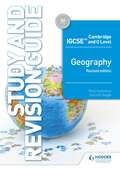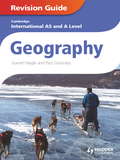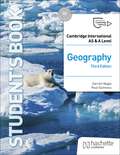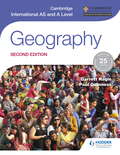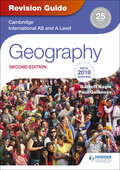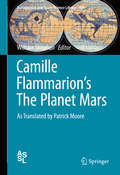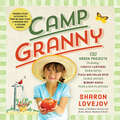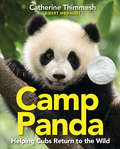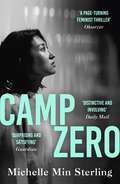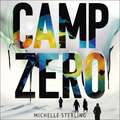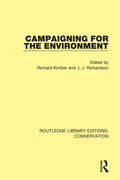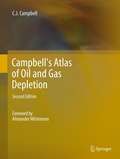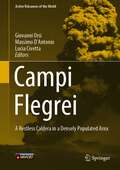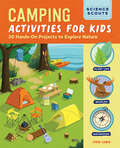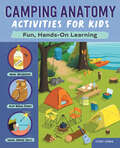- Table View
- List View
Cambridge IGCSE and O Level Geography Study and Revision Guide revised edition
by Garrett Nagle Paul GuinnessSend students into their exam with the confidence to achieve their maximum potential using step-by-step guidance that helps to practise skills learned and improve exam technique.- Avoid common misconceptions with frequent mistakes highlighted throughout - Build students' skills constructing and writing answers with a range of practice and exam-style questions- Easily identify areas for improvement with the answers in the back of the book- Help students target their revision and focus on important concepts and skills with key objectives at the beginning of every chapter- Ensure that students maximise their time in the exam with examiner's tips and suggestions on how to approach questions- Contextualise knowledge with authentic case studiesThis Study and Revision Guide has been updated for the latest syllabus for examination from 2020. This title has not been through the Cambridge Assessment International Education endorsement process.
Cambridge International A and AS Level Geography Revision Guide ePub
by Garrett Nagle Paul GuinessGet your best grades with this Cambridge International AS and A Level Geography Revision Guide.Manage your own revision with step-by-step support from experienced examiners Garrett Nagle and Paul GuinnessUse specific case studies to improve your knowledge of geographical patterns, processes and changesGet the top marks by applying geographical terms accurately with the help of definitions and key wordsUse the Revision Guide to prepare for the big day:Plan and pace your revision with the revision plannerUse the expert tips to clarify key pointsAvoid making typical mistakes with expert adviceTest yourself with end-of-topic questions and answers and tick off each topic as you complete itPractise your exam skills with exam-style AS and A2 questionsThe Revision Guide also has:Coverage of the whole syllabus, including all 8 optionsAn international focus, including examples and case studies from around the world.Also available: Cambridge International A and AS Level Geography textbook (ISBN: 9781444123166) by Garrett Nagle and Paul Guinness and endorsed by University of Cambridge International Examinations.This title has not been through the Cambridge endorsement process.
Cambridge International AS & A Level Geography Third Edition
by Garrett Nagle Paul GuinnessThis title is endorsed for the Cambridge Pathway to support the syllabuses for examination from 2027.Introducing the third edition of our Student's Book to cover the updated Cambridge International AS and A Level Geography syllabus (9696) for examination from 2027, part of a suite of print and digital resources to support teaching and learning.- Trust experienced authors to guide you through the updated syllabus with comprehensive coverage of the new content, a refreshed design and individual chapters on each topic.- Build and reinforce understanding of all learners with a clear layout, accessible language, terminology and illustrations, and ESL-friendly key terms.- Build geographical skills with clear guidance and practice, including advice on fieldwork.- Ensure complete coverage with the core syllabus and all the human and physical geography options included.- Prepare for assessment and check understanding with new analyses of detailed specific examples, updated practice questions and knowledge tests at the end of each topic.- Provide an international focus with a wide range of global examples whilst encouraging students to make links with their local contexts. Auto-marked knowledge tests are available via the eBook version at the end of each topicAnswers to all the practice questions and activities are FREE to download from: www.hachettelearning.com/answers-and-extras
Cambridge International AS & A Level Geography Third Edition
by Garrett Nagle Paul GuinnessThis title is endorsed for the Cambridge Pathway to support the syllabuses for examination from 2027.Introducing the third edition of our Student's Book to cover the updated Cambridge International AS and A Level Geography syllabus (9696) for examination from 2027, part of a suite of print and digital resources to support teaching and learning.- Trust experienced authors to guide you through the updated syllabus with comprehensive coverage of the new content, a refreshed design and individual chapters on each topic.- Build and reinforce understanding of all learners with a clear layout, accessible language, terminology and illustrations, and ESL-friendly key terms.- Build geographical skills with clear guidance and practice, including advice on fieldwork.- Ensure complete coverage with the core syllabus and all the human and physical geography options included.- Prepare for assessment and check understanding with new analyses of detailed specific examples, updated practice questions and knowledge tests at the end of each topic.- Provide an international focus with a wide range of global examples whilst encouraging students to make links with their local contexts. Auto-marked knowledge tests are available via the eBook version at the end of each topicAnswers to all the practice questions and activities are FREE to download from: www.hachettelearning.com/answers-and-extras
Cambridge International AS and A Level Geography second edition
by Garrett NagleWe are working with Cambridge International Examinations to gain endorsement for this edition for the revised 2017 syllabus.- Covers the full content of the syllabus- Written by the same renowned author team as the first edition and the bestsellingCambridge IGCSE Geography- Supports the development of geographical skills, which feature more prominently in thelatest syllabus
Cambridge International AS and A Level Geography second edition
by Garrett NagleEndorsed by Cambridge Assessment International Education for full syllabus coverage.Rely on a course with international focus and examples and case studies from around the world, which has been especially written to cover the Cambridge International AS & A Level Geography syllabus for examination from 2018 (9696).- Build geographical skills with clear guidance and practice, including advice on fieldwork- Ensure complete coverage with the core syllabus and all the human and physical geography options included- Provide an international focus with examples and case studies from around the world
Cambridge International AS/A Level Geography Revision Guide 2nd edition
by Garrett Nagle Paul GuinnessReinforce and practice skills learned with step-by-step support from experts to help you achieve your maximum potential.- Improve your knowledge of geographical patterns, processes and changes with internationally focussed examples and case studies from around the world.- Clarify key points and ensure common mistakes are avoided with expert advice and tips.- Test and consolidate your knowledge with end of topic questions and answers, and exam-style questions for AS and A2 levels.- Plan and pace your revision with the revision planner.
Cambridge International AS/A Level Geography Revision Guide 2nd edition
by Garrett Nagle Paul GuinnessExam board: Cambridge Assessment International EducationLevel: A-levelSubject: GeographyFirst teaching: September 2016First exams: Summer 2018 Reinforce and practise skills learned with step-by-step support from experts to help you achieve your maximum potential.- Improve your knowledge of geographical patterns, processes and changes with internationally focussed examples and case studies from around the world.- Clarify key points and ensure common mistakes are avoided with expert advice and tips.- Test and consolidate your knowledge with end of topic questions and answers, and exam-style questions for AS and A2 levels.- Plan and pace your revision with the revision planner.
Cambridge International Trade and Economic Law: Export Restrictions on Critical Minerals and Metals
by Ilaria EspaConventional wisdom on the insufficiency of existing WTO disciplines on export restrictions has triggered momentum on the issue. In this book, Ilaria Espa offers a comprehensive analysis of the scope and coverage of WTO disciplines on export restrictions in light of emerging case law. She investigates whether such rules still provide a sufficient, credible and effective framework capable of preventing abuses in the use of export restrictive measures on critical minerals and metals during a period of economic crisis and change in international trade patterns. Giving a broad overview of the export restrictions applied to these materials, Espa identifies distinctive features in the proliferation of export barriers and analyses the existing WTO rules to reveal their scope, gaps and inconsistencies. She goes on to present solutions based upon her findings with the aim of bringing more coherence and equity to WTO rules on the export side.
Cambridge Manuals in Archaeology: Applied Soil Micromorphology in Archaeology (Cambridge Manuals in Archaeology)
by Paul Goldberg Richard I. MacphailApplied Soils and Micromorphology in Archaeology provides the most up-to-date information on soil science and its applications in archaeology. Based on more than three decades of investigations and experiments, the volume demonstrates how description protocols and complimentary methods (SEM/EDS, microprobe, micro-FTIR, bulk soil chemistry, micro- and macrofossils) are used in interpretations. It also focuses on key topics, such as palaeosols, cultivation, and occupation surfaces, and introduces a range of current issues, such as site inundation, climate change, settlement morphology, herding, trackways, industrial processes, funerary features, and site transformation. Structured around important case studies, Applied Soils and Micromorphology in Archaeology is thoroughly-illustrated, with color plates and figures, tables and other ancillary materials on its website (www. cambridge. org/9781107011380); chapter appendices can be accessed separately using the web (www. geoarchaeology. info/asma). This new book will serve as an essential volume for all archaeological inquiry about soil.
Cambridge Social and Cultural Histories: Renaissance Ethnography and the Invention of the Human
by Surekha DaviesGiants, cannibals and other monsters were a regular feature of Renaissance illustrated maps, inhabiting the Americas alongside other indigenous peoples. In a new approach to views of distant peoples, Surekha Davies analyzes this archive alongside prints, costume books and geographical writing. Using sources from Iberia, France, the German lands, the Low Countries, Italy and England, Davies argues that mapmakers and viewers saw these maps as careful syntheses that enabled viewers to compare different peoples. In an age when scholars, missionaries, native peoples and colonial officials debated whether New World inhabitants could – or should – be converted or enslaved, maps were uniquely suited for assessing the impact of environment on bodies and temperaments. Through innovative interdisciplinary methods connecting the European Renaissance to the Atlantic world, Davies uses new sources and questions to explore science as a visual pursuit, revealing how debates about the relationship between humans and monstrous peoples challenged colonial expansion.
Cambridge Studies in Biological and Evolutionary Anthropology: Demography and Evolutionary Ecology of Hadza Hunter-Gatherers
by Nicholas Blurton JonesThe Hadza, an ethnic group indigenous to northern Tanzania, are one of the few remaining hunter-gatherer populations. Archaeology shows 130,000 years of hunting and gathering in their land but Hadza are rapidly losing areas vital to their way of life. This book offers a unique opportunity to capture a disappearing lifestyle. Blurton Jones interweaves data from ecology, demography and evolutionary ecology to present a comprehensive analysis of the Hadza foragers. Discussion centres on expansion of the adaptationist perspective beyond topics customarily studied in human behavioural ecology, to interpret a wider range of anthropological concepts. Analysing behavioural aspects, with a specific focus on relationships and their wider impact on the population, this book reports the demographic consequences of different patterns of marriage and the availability of helpers such as husbands, children, and grandmothers. Essential for researchers and graduate students alike, this book will challenge preconceptions of human sociobiology.
Cambridge Studies in Contentious Politics: Networks in Contention
by Jennifer HaddenHow do civil society organizations mobilize on climate change? Why do they choose certain strategies over others? What are the consequences of these choices? Networks in Contention examines how the interactions between different organizations within the international climate change movement shape strategic decisions and the kinds of outcomes organizations are able to achieve. First, it documents how and why cleavages emerged in this once-unified movement around the time of the 2009 Copenhagen Summit. Second, it shows how an organization's position in the movement's network has a large influence on the tactics it adopts. Finally, it demonstrates how the development of new strategies within this network has influenced the trajectory of global climate politics. The book establishes the ways in which networks are consequential for civil society groups, exploring how these actors can become more effective and suggesting lessons for the future coordination of activism.
Cambridge Studies in Early Modern British History: The Smoke of London
by William M. CavertThe Smoke of London uncovers the origins of urban air pollution, two centuries before the industrial revolution. By 1600, London was a fossil-fuelled city, its high-sulfur coal a basic necessity for the poor and a source of cheap energy for its growing manufacturing sector. The resulting smoke was found ugly and dangerous throughout the seventeenth and eighteenth centuries, leading to challenges in court, suppression by the crown, doctors' attempts to understand the nature of good air, increasing suburbanization, and changing representations of urban life in poetry and on the London stage. Neither a celebratory account of proto-environmentalism nor a declensionist narrative of degradation, The Smoke of London recovers the seriousness of pre-modern environmental concerns even as it explains their limits and failures. Ultimately, Londoners learned to live with their dirty air, an accommodation that reframes the modern process of urbanization and industrial pollution, both in Britain and beyond.
Cambridge Studies in International and Comparative Law: Climate Change Litigation
by Hari M. Osofsky Jacqueline Peel Peel, Jacqueline and Osofsky, Hari M.This examination of the role of litigation in addressing the problem of climate change focuses not only on how the massive and growing number of lawsuits influences regulation directly, but also on how the lawsuits shape corporate behaviour and public opinion. It provides readers with an understanding of how these lawsuits have shaped approaches to mitigation and adaptation, and have been used to try to force and to block regulation. There is a particular emphasis on lawsuits in the United States and Australia, the two jurisdictions which have had the most climate change litigation in the world, and the lessons provide broader insights into the role of courts in addressing climate change.
Camille Flammarion's The Planet Mars: As Translated by Patrick Moore (Astrophysics and Space Science Library #409)
by Camille Flammarionwilliam SheehanCamille Flammarion (1842-1925) began his career at 16 as a human computer under the great mathematician U. J. J. Le Verrier at the Paris Observatory. He soon tired of the drudgery; he was drawn to more romantic vistas, and at 19 wrote a book on an idea that he was to make his own--the habitability of other worlds. There followed a career as France's greatest popularizer of astronomy, with over 60 titles to his credit. An admirer granted him a chateau at Juvisy-sur-l'Orge, and he set up a first-rate observatory dedicated to the study of the planet Mars. Finally, in 1892, he published his masterpiece, La Planete Mars et ses conditions d'habitabilite, a comprehensive summary of three centuries' worth of literature on Mars, much of it based on his own personal research into rare memoirs and archives. As a history of that era, it has never been surpassed, and remains one of a handful of indispensable books on the red planet. Sir Patrick Moore (1923-2012) needs no introduction; his record of popularizing astronomy in Britain in the 20th century equaled Flammarion's in France in the 19th century. Moore pounded out hundreds of books as well as served as presenter of the BBC's TV program "Sky at Night" program for 55 years (a world record). Though Moore always insisted that the Moon was his chef-d'oeuvre, Mars came a close second, and in 1980 he produced a typescript of Flammarion's classic. Unfortunately, even he found the project too daunting for his publish ers and passed the torch of keeping the project alive to a friend, the amateur astronomer and author William Sheehan, in 1993. Widely regarded as a leading historian of the planet Mars, Sheehan has not only meticulously compared and corrected Moore's manuscript against Flammarion's original so as to produce an authoritative text, he has added an important introduction showing the book's significance in the history of Mars studies. Here results a book that remains an invaluable resource and is also a literary tour-de-force, in which the inimitable style of Flammarion has been rendered in the equally unique style of Moore.
Camp Granny: A Grandma's Bag of Tricks
by Sharon Lovejoy<P>Make leaf rubbings, blow jumbo bubbles, bake Moon Pizzas, create a firefly lantern. More than an activity book, CAMP GRANNY is an interactivity book, filled with 130 projects that connect grandparents and grandchildren through nature—in the kitchen, the garden, and the art room. <P>Illustrated with evocative photographs and the author’s watercolors, CAMP GRANNY is a book about being adventurous, about being curious, about noticing and really seeing things—about instilling a lifelong sense of wonder. <P>Please note: CAMP GRANNY was previously sold under the title Toad Cottages & Shooting Stars.
Camp Panda: Helping Cubs Return to the Wild
by Catherine ThimmeshFrom the Sibert medal winning author of TEAM MOON and the bestselling GIRLS THINK OF EVERYTHING comes a riveting, timely account of panda conservation efforts in China, perfect for budding environmentalists and activists. <P><P>Roughly a thousand years ago, an estimated 23,000 pandas roamed wild and free through their native China. But within the past forty years, more than fifty percent of the panda’s already shrinking habitat has been destroyed by humans, leaving the beautiful and beloved giant panda vulnerable to extinction. <P><P>Despite the seemingly insurmountable odds—poaching, habitat destruction, pollution, human overpopulation, and global climate change—the panda is making a comeback. How? By humans teaching baby pandas how to be wild and stay wild.
Camp Zero
by Michelle Min Sterling'A cold, hungry adventure story about the power of choice and the strength of solidarity' SEAN MICHAELSAmerica, 2049: Summer temperatures are intolerably high, the fossil fuel industry has shut down, and humans are implanted with a 'Flick' at birth, which allows them to remain perpetually online. The wealthy live in the newly created Floating City off the coast, while people on the mainland struggle to get by. For Rose, a job as a hostess in the city's elite club feels like her best hope for a better future. At a Cold War-era research station, a group of highly trained women with the code name White Alice are engaged in climate surveillance. But the terms of their employment become increasingly uncertain. And in a former oil town in northern Canada called Dominion Lake, a camp is being built-Camp Zero. A rare source of fresh, clean air and cooler temperatures, it will be the beginning of a new community and a new way of life. Grant believes it will be the perfect place to atone for his family's dark legacy. Everyone has an agenda. So who can you trust? Could falling in love be most the radical act of all? Thrilling, immersive and disturbingly prescient, Camp Zero is about the world we've built and where we go from here.
Camp Zero
by Michelle Min Sterling'A cold, hungry adventure story about the power of choice and the strength of solidarity' SEAN MICHAELSThe old world is broken. Be part of a better future.America, 2049: Summer temperatures are intolerably high, the fossil fuel industry has shut down, and humans are implanted with a 'Flick' at birth, which allows them to remain perpetually online. The wealthy live in the newly created Floating City off the coast, while people on the mainland struggle to get by. For Rose, a job as a hostess in the city's elite club, feels like her best hope for a better future. At a Cold War-era research station, a group of highly-trained women with the code-name White Alice are engaged in climate surveillance. But the terms of their employment become increasingly uncertain. And in a former oil town in northern Canada called Dominion Lake, a camp is being built-Camp Zero. A rare source of fresh, clean air and cooler temperatures, it will be the beginning of a new community and a new way of life. Grant believes it will be the perfect place to atone for his family's dark legacy. Everyone has an agenda. So who can you trust? Could falling in love be most the radical act of all? Thrilling, immersive and disturbingly prescient Camp Zero is about the world we've built and where we go from here.(P)2023 Hodder & Stoughton Limited
Campaigning for the Environment (Routledge Library Editions: Conservation #8)
by Richard Kimber Jeremy RichardsonOriginally published in 1974 Campaigning for the Environment addresses the issue of the environmental lobby. Using seven case-studies from the time of publication, the book covers the important aspects of environmental campaigning, where the environment has been threatened and where pressure groups have been formed to defend it. The book discusses the political problems of protecting and improving the environment, and states that each campaign involves taking on major sections of the political system. Despite having been published over 40 years ago, the commentary of the book, and the analysis in the case studies is still as relevant today as it was then. This book will be of interest to academics working in the field of environment and sustainability, conservation and political studies.
Campbell's Atlas of Oil and Gas Depletion
by Alexander Wöstmann Colin J CampbellCampbell's Atlas of Oil and Gas Depletion, Second Edition, is the product of a half-century of critical analysis and updating of data on the status of oil and gas depletion by country, region and the world as a whole. Separate analyses of conventional and non-conventional oil and gas, which are depleting at different rates and costs, show when these critical energy sources peak and decline. The Atlas also summarizes the history and political circumstances of each country to assess the impact on oil and gas production and reserves. It contrasts the First Half of the Oil Age, which saw the rapid expansion of the world economy, allowing the population to grow six-fold, with the Second Half, which will witness a general contraction as these easy, high-density energy supplies dwindle. The transition threatens to be a time of great economic, financial and political tensions. The Atlas, which has been compiled and updated by prominent geologist, former oil company executive, and oil analyst Colin Campbell since the 1960s, addresses the need for a reliable and comprehensive database on a subject essential to governments, industry, academia, and the population as a whole as we attempt to adapt to these critically changing circumstances.
Campi Flegrei: A Restless Caldera in a Densely Populated Area (Active Volcanoes of the World)
by Giovanni Orsi Massimo D’Antonio Lucia CivettaThe densely populated Campi Flegrei resurgent caldera is one of the widest known, best studied and highly dangerous volcanoes of the world. This monograph synthesises the current knowledge of this volcano, through different review chapters. Each chapter of this book is dedicated to a specific volcanological aspect, authored by well-recognised experts. The volume attempts to cross the barriers between the volcanological, geological, geochemical and geophysical perspectives, and offers a comprehensive and up-to-date reference to earth-science scholars, as well as land planners and civil defence officers.
Camping Activities for Kids: 20 Hands-On Projects to Explore Nature (Science Scouts)
by Steve LemigGoing on a camping trip? Encourage kids to explore like a scientist with an illustrated camping activity guide for ages 8 to 12.Attention campers! Are you ready to think like a scientist and adventure like an explorer? This fun and interactive guide shows kids how to camp with an active mind for learning. They'll discover all the different items you need to go camping, the steps to building an awesome campsite, and how to make the most of exploring nature through 20 lessons and 20 activities to try on the trails!Explore and play—Help kids get hands-on as they make their own thermometer and solar still, find true north, learn how to safely watch nearby wildlife, and so much more.The 5 Science Scout skills—Kids will practice the key skills that scientists and explorers use to discover the world as they Observe, Ask, Imagine, Test, and Reflect.Start a camping journal—Journal pages and writing prompts will inspire kids to record their ideas and observations as they create a book of amazing camping memories!Introduce curious kids to the science of camping with Camping Activities for Kids—part of the Science Scouts series!
Camping Anatomy Activities for Kids: Fun, Hands-On Learning (Anatomy Activities for Kids)
by Steve LemigExplore like a scientist with this illustrated camping guide for kids ages 8 to 12Camping is the perfect time to learn about the world around you. Adventure through nature like a real scientist with Camping Anatomy Activities for Kids. It's full of super-fun activities and lessons that show you how to build a working campsite, stay safe on the trail, and much more! You'll learn new camping skills and keep track of everything you discover as you become an outdoor lover for life.Go beyond other camping books for kids and:Experience the wilderness—20 unique lessons teach you how to ask questions about the natural world, imagine solutions to potential problems, and test ideas to prepare for a successful camping trip.Try awesome activities—Get your campsite up and running with activities like pitching a tent, reading the stars, and drawing a map.Start a camping journal—Use your own blank journal to answer writing prompts that help you record your ideas and observations.Become an expert camper as you interact with the outdoors through this nature journal for kids.
